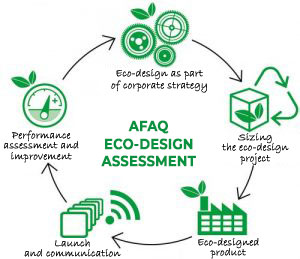- 2-1 Mastering LCA and eco-design
- 2-2 Improving your asbestos diagnosis skills
- 2-3 Become an ISO 14001 auditor and master the standard

Mastering LCA and eco-design
Ecodesign involves designing a product in such a way as to minimize the impact of its use and end-of-life on the environment. To be effective, this multi-criteria approach requires tools that must be handled with great rigor. So you need to be trained.

L’écoconception suppose de mener, en amont, une analyse du cycle de vie (ACV), une méthode parfois appelée à tort « écobilan », et qui va plus loin qu’un simple bilan carbone. Celui-ci mesure les émissions de gaz à effet de serre à différentes étapes de la vie d’un objet. Appliqué à la fabrication de journaux, par exemple, le bilan carbone ne prend pas en compte l’origine du papier ou la qualité des encres, critères pourtant déterminants pour savoir si le produit est écologique. L’ACV, elle, inventorie tous les flux de matières et d’énergies entrants et sortants à chaque étape de la vie d’un produit : extraction de matières premières, fabrication, distribution, utilisation, fin de vie.
Ces données permettent d’établir les étapes les plus impactantes, et d’identifier quels indicateurs écologiques elles dégradent le plus : acidification des sols, émissions de CO2, eutrophisation des eaux, épuisement des ressources naturelles, etc. C’est ainsi qu’une grande enseigne d’équipements sportifs s’est aperçue que le principal impact CO2 de sa doudoune de trek venait… de la teinture de la doublure intérieure. Un procédé innovant de tissage, mélange d’un fil noir avec un fil non teint a permis de réduire de 40 % les émissions de CO2.
ACV et éco-conception : trois normes à bien connaître
Qu’est-ce que la méthode ACV ?
La démarche d’écoconception est une démarche d’arbitrage entre les coûts économiques et les coûts environnementaux, mais aussi entre différents impacts environnementaux. Un exemple : isoler un bâtiment diminue sa consommation d’énergie à l’usage. Cependant, le chantier d’isolation nécessite matériaux, transport et énergie. Raisonner en cycle de vie permet donc de savoir si l’effet produit est réellement positif ou négatif.

Que vous soyez chef de produit, responsable marketing, ingénieur environnement (R&D ou production) mais aussi designer ou consultant indépendant, des formations permettent de découvrir, comprendre et s’approprier la méthode ACV et l’écoconception. En effet, conduire ces deux démarches ne s’improvise pas. La mise en place des solutions efficaces nécessite le recours à de nombreux outils, principes et raisonnements spécifiques, comme l’analyse multicritères ou l’unité fonctionnelle. Elle passe aussi par la manipulation de logiciels et de bases de données spécialisées.
Maîtriser les fondamentaux passe par la connaissance des normes ISO 14040 et 14044. Ces standards internationaux établissent le cadre méthodologique pour réaliser une ACV rigoureuse et fiable. La norme ISO 14006 vient compléter ce socle en définissant les lignes directrices pour intégrer l’éco-conception dans les systèmes de management.
L’application de ces référentiels garantit une évaluation précise des impacts environnementaux sur l’ensemble du cycle de vie. Les entreprises peuvent alors prendre des décisions éclairées grâce à des résultats comparables et vérifiables.
Être compétent sur le sujet suppose aussi de bien connaître les normes volontaires en la matière :
- la norme ISO 14040 présente la démarche générale de l’ACV et ses différentes étapes ;
- la norme ISO 14044 se focalise sur l’étape de l’évaluation et de la hiérarchisation des impacts environnementaux ;
- la norme NF X30-264 donne des lignes directrices pour mettre n place une démarche d’écoconception